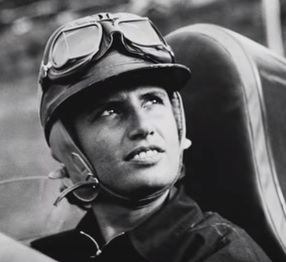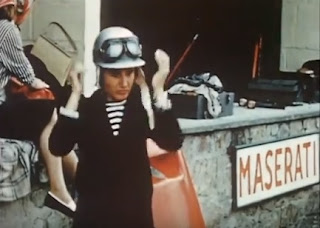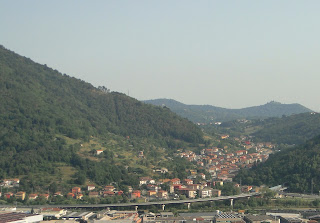Pioneer for women behind the wheel
 |
| Maria Teresa de Filippis in 1958 |
The racing driver Maria Teresa de Filippis, who was the
first woman to compete in a Formula One world championship event and remains
one of only two to make it on to the starting grid in the history of the
competition, died on this day in 2016 in Gavarno, a village near Bergamo in
Lombardy.
De Filippis, a contemporary of the early greats of F1, the
Italians Giuseppe Farina and Alberto Ascari and the Argentine Juan Manuel
Fangio, qualified for the Belgian Grand Prix in June 1958 and finished 10th.
She made the grid for the Portuguese and Italian Grands Prix
later in the year but had to retire from both due to engine problems.
She managed only six laps in the former but was unlucky not
to finish in the latter event at Monza, where she completed 57 of the 70 laps.
Although she was at the back of the field, 13 other cars had retired earlier in
the race and she would therefore have finished eighth.
These were her only F1 races. The following year she turned
her back on the sport following the death of her close friend, the French
driver Jean Behra, in a crash in Germany. Only a year earlier, her former
fiancé, the Italian driver Luigi Musso, had also been killed.
 |
| De Filippis prepares to take the wheel outside the Maserati garage during the 1958 season |
De Filippis came from a wealthy background, born in Naples in
1926 and brought up in the 16th century Palazzo Marigliano. Her family,
with aristocratic roots, also owned the Palazzo Bianco in Caserta.
A keen horsewoman, she also loved skiing and tennis as a
teenager but took up car racing in order to prove a point to her two older
brothers, Antonio and Giuseppe, who had teased her about her prowess at the
wheel.
Determined to prove them wrong, at 22 she entered her first
race, a hill climb between the port of Salerno and the town of Cava di Tirreni,
10km (6 miles) inland, and won.
Finding, to her surprise, that she had no fear behind the
wheel she quickly progressed to sports car events, finishing second in the 1954
Italian sports car championship.
It was at the sports car race that accompanied the 1956
Naples Grand Prix that De Filippis caught the eye. Driving a works-entered Maserati 200S on a circuit
that followed the walled streets and tree-lined boulevards of Posillipo, an
upmarket residential area of her home city, she started at the back of the grid
after missing practice but worked her way through the field to finish second.
 |
| Maria Teresa de Filippis pictured at the age of 88 |
The invitation to compete in Formula One soon followed and
it was in the Maserati 250F, the same car that took Fangio to his fifth world
title the previous year, that she made her historic debut at the
Spa-Francorchamps circuit.
Although a woman in motorsport was not a new phenomenon –
the French driver and aviator Camille du Gast had taken part in the 1901 Paris
to Berlin rally – Formula One was a wholly male-dominated world and there were
considerable barriers to overcome.
Stirling Moss, the British driver she considered a friend,
doubted whether a woman had the strength to handle an F1 car at speed, while
the director of the French Grand Prix at Reims that followed the Belgian race
allegedly barred her from taking part, telling her – in her words – that “the
only helmet a woman should wear is the one at the hairdressers.”
It was at the French Grand Prix that Luigi Musso died.
Although they had broken off their engagement and he had a new girlfriend, his
death hit De Filippis hard nonetheless and made her think about whether she
wanted to continue.
As the only female driver, she was never short of attention,
but one of the fans to whom she was introduced at her Monza appearance in 1958,
an Austrian textile chemist by the name of Theodor Huschek, made a bigger
impression than others.
 |
| The iconic Maserati 250F |
She bumped into him again in Istanbul the following year and
after meeting for a third time on a skiing trip they became engaged and married.
After living in Austria and Switzerland they moved to Cortina d’Ampezzo in the
Dolomites, then to Rome and next Capri, the idyllic island in the Bay of
Naples.
They had a daughter, Carola, and settled in Bergamo area
when Theodor began working for the Legler textile firm in Ponte San Pietro, to
the northwest of the city. They settled in Gavarno, a village between Scanzorosciate
and Nembro.
Despite De Filippis having broken new ground for women in motor racing, the only other female driver to participate in a Formula One race is Lella Lombardi, her fellow Italian, who started 12 times between 1974 and 1976.
In later life, De Filippis was vice-president of the International Club of Former F1 Grand Prix Drivers.
 |
| The facade of the Palazzo Marigliano |
Travel tip:
The Palazzo Marigliano, built in the early 16th
century, is the former home of Andrea de Capua, the fourth Count of Altavill
and the chief legal executive for the Kingdom of Naples. It was refurbished in
the 1750s with frescoes by Francesco de Mura and paintings by Giovanni Battista
Maffei. It can be found right in the heart of the city in Via San Biagio dei
Librai, which forms part of the historic Spaccanapoli, the narrow, straight thoroughfare
that runs in a 2km (1.25 miles) diagonal across the city. Today the beautiful
inner courtyard hosts artisan workshops and part of the palace is given over to
apartments.
 |
| Gavarno is situated in a wooded valley near Bergamo |
Travel tip:
Gavarno is a village of some 1,200 residents a few
kilometres to the northeast of Bergamo overlooking the stream of the same name
that joins the Serio river at nearby Nembro. Built largely on a gentle
hillside, it is in an area popular with walkers, offering pleasant woodland
paths. Between Gavarno and Nembro there is a interesting modern church,
consecrated only in 2000, dedicated to Pope Giovanni XXIII, who hailed from
Sotto il Monte in Bergamo province.